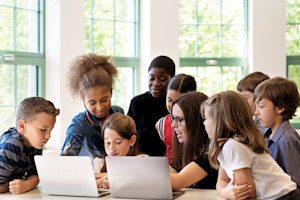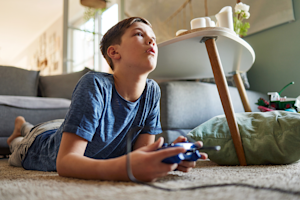
Digital wellness
Celebrating Media Literacy Week: Media Stamped wins international recognition
Award-winning digital literacy resources now available to Canadian educators.
Read article
Amanda Lee
Senior Program Manager, Tech for Good™ & TELUS Wise®

Back to school in 2020 is anything but normal. Across the country, and even across schools, there are different plans for returning to class and remote learning. While there is still a lot of uncertainty, kids and parents do know that things like physical distancing, hand hygiene, cohorts and self-screening will be as much a part of the school day as reading, writing and arithmetic.
Most kids will experience a combination of in-class and remote learning in their 2020/2021 school years. Many parents will still be working from home while their kids are learning at home. How can parents use technology to help their kids stay focused, organized and productive? These apps can help.
Learning how to organize your tasks and time is an important skill, both in school and in life. No matter how old your students are, there are apps that can help them stay organized and on task.
With both free and paid versions, older students can keep track of assignments, tests and projects, and receive rewards for completing homework on time.
Purp is a task and goal manager, which allows students to track goals, tasks and projects on their devices of choice. The free version offers tracking for five goals, while the paid version allows unlimited goals.
Originally created for families with kids with ADHD, this app provides family-based task management. Described as a life management solution, kids get a “personal assistant,” so parents don’t have to shoulder the full responsibility of reminding their kids about school projects, tasks and even chores. Parents also get real-time visibility into how kids are using the app. The app is free to try, with a paid subscription.
When students are learning online, note taking can be critical for retention and recall. These apps can help with note taking, secure storage and file sharing.
This free app allows students to take notes and organize them. They can also sync across devices, so if a student starts a note on his or her phone, it can be completed on the computer.
Dropbox provides cloud-based storage, where you can back up files automatically or manually and avoid any chance of your kids’ assignments, group work or papers getting lost. You can also easily share files/folders with other Dropbox users or send non-users a link that they can use to view or download the file/folder. The app provides up to 2GB for free, with more storage for a fee.
Screens can be distracting, as much as they can help with productivity. In addition to using iPhone’s Screen Time or Android’s Digital Wellbeing to track and manage your kids’ activities on apps, you can use the apps listed below to help keep them focused and motivated.
Designed for older students, Self Control helps students avoid distracting websites (think social media, videos and gaming). Free for Mac, students can block their own access for selected time periods.
Flipd helps students spend their time well by staying mindful, focused and on track. Audio content is available to support mindfulness, whether it’s focus, sleep, relaxing or breathing. Daily, weekly and monthly stats are available to track productivity, and students can join communities and challenges. Free and paid versions are available.
Students often have to sign contracts with their teachers at the start of the school year. So considering that you are probably going to be both a parent and a teacher of sorts this year, you may want to consider a “digital learning pledge” for online learning.
Common Sense, a leading non-profit organization dedicated to improving the lives of all kids and families by providing the trustworthy information about media and technology, offers a great pledge template for grades K to five and grades six to 12. You can use the templates as is or customize them for your family.
The pledge covers responsibilities including:
With a pledge in place, you can create accountability around digital citizenship in your home-based learning environment.
With a hybrid in-class remote learning model, technology plays an even more significant role in kids’ lives than it did before. That’s why safety, digital citizenship, awareness and vigilance are even more critical. With the use of these apps, you can help your kids stay focused, organized and productive while keeping them safe, reinforcing respectful online behaviours, and helping them acclimatize to a new way of learning and engaging.

Award-winning digital literacy resources now available to Canadian educators.
Read article
Learn how gaming and gambling features blur for kids.
Read articleLearn how screen time triggers dopamine responses. Students explore digital media's biological impact and develop healthier digital habits.
Watch video